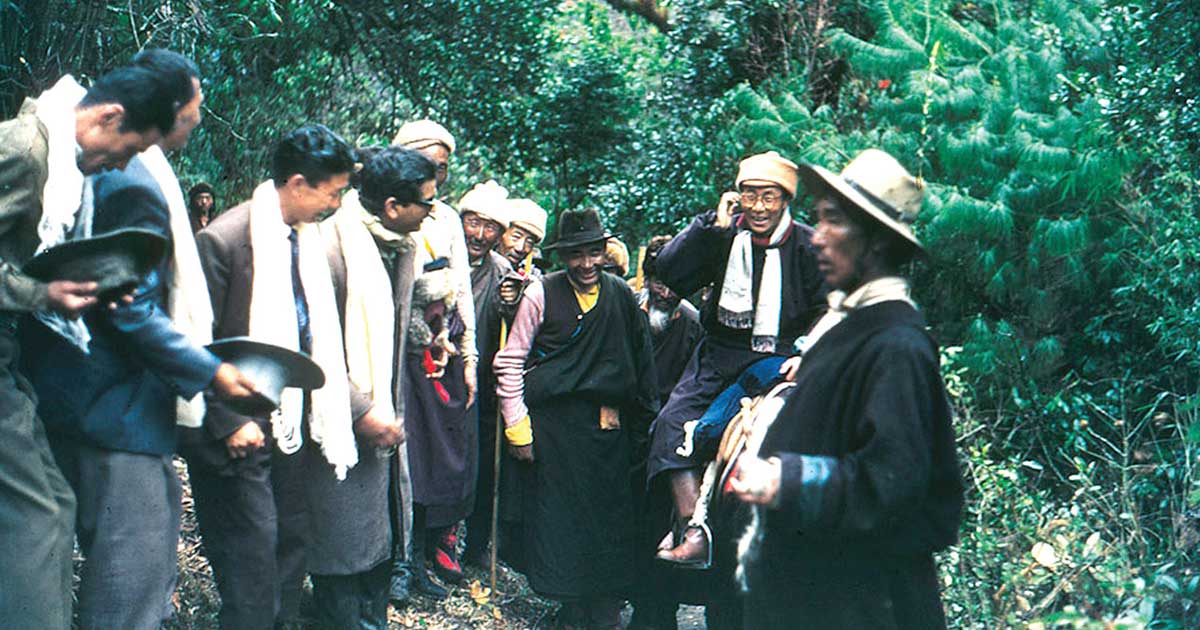By Dekyi Sharchitsang
Dekyi Sharchitsang is an intern at the International Campaign for Tibet and a student at Emory University.

The Dalai Lama reaches safety in India on March 31, 1959. (Tibet Museum)
Upon reaching India, he was swiftly received by border authorities, who led him to a town in the present-day Indian state of Arunachal Pradesh. He had been granted political asylum by Prime Minister Nehru and the Indian government, as had the many thousands of Tibetans who followed him into exile with no knowledge of what would become of them.
That was 63 years ago. He was only 23 years old.
His Holiness is now 86 and has not returned to Tibet since his fateful escape. This is not by choice. He has often expressed his desire to see Tibet once again with his own eyes, yet China remains intent on denying him this homecoming. Although he is optimistic, returning to Tibet remains a distant dream.
Since his escape in 1959, His Holiness has led a remarkable life in exile. For many newly arrived Tibetan refugees, who had lost everything to Chinese occupation, their only consolation was the spirit of His Holiness. Although all else was gone, either left in Tibet or lost along the way, His Holiness’ grace and guidance remained constant. As tens of thousands of stateless Tibetans now looked to him for direction, he was confronted with an immense challenge: rebuilding a nation.
From the very beginning, he prioritized the well-being of the Tibetan people. Within his first year in India, His Holiness established various institutions that remain intact to this day, beginning with the creation of a central government consisting of several administrative departments such as Information, Education, Religious Affairs and Security, among others. Realizing the importance of a modern education, His Holiness also oversaw the creation of Tibetan schools for the thousands of refugee children who would now be brought up in exile.
On the first anniversary of the Tibetan People’s Uprising in March 1960, His Holiness made a statement to the Tibetan people, reminding them to remain hopeful even in the face of adversity:
“On this first occasion, I stressed the need for my people to take a long-term view of the situation in Tibet. For those of us in exile, I said that our priority must be resettlement and the continuity of our cultural traditions. As to the future, I stated my belief that, with truth, justice, and courage as our weapons, we Tibetans would eventually prevail.”
Bearing the weight of a wounded nation at 23 years old, His Holiness, through his selflessness, compassion and dedication to the Tibetan cause, lifted thousands of Tibetan refugees out of despair and transformed them into a thriving exiled community.
For many young Tibetans like myself who’ve grown up in the US, Tibet is a place that lives in our minds, but America is the only home we’ve ever known. My identity as a Tibetan American has always been plagued by feelings of cultural alienation and detachment, especially considering that, after six decades in exile, I am two generations removed from Tibet. This experience is hardly unique. It has instead come to define the Tibetan diaspora, as there are now entire generations of Tibetans who have not known a life other than one in exile.
Today, it is no secret that the state of Tibet remains precarious. Assaults on human rights and religious freedoms, severe censorship and surveillance, and violent suppression of dissent occur regularly with little international attention. Despite this, Tibetans are resilient, finding strength in each other and in the teachings of His Holiness, just as they have since 1959.
I am now almost the age that His Holiness was when he escaped Tibet, and just like him, I too wish for a swift homecoming. As a Tibetan American, I have been afforded the tremendous privilege of living in the free world. I can attend March 10 protests every year, speak Tibetan, express my political views and practice Buddhism, all without fear of retribution. Unlike the Tibetans living under Chinese occupation, and unlike the generations of Tibetans who came before me, I have the luxury of opportunity, and the freedom of choice. I stand on the sacrifices of these Tibetans who paved the way for my generation of Tibetan youth to be able to live freely and as our authentic selves.
Sixty-three years have passed since 1959, but the spirit of the Tibetan people remains alive. Our collective resistance to injustice and occupation persists with vigor.
A new documentary on the Dalai Lama’s escape is coming to theaters soon. “Never Forget Tibet: The Dalai Lama’s Untold Story” will premiere at 800 theaters across the United States and Canada for one night only on March 31, the 63rd anniversary of the Dalai Lama’s safe arrival in India.
Buy your tickets now. (Note: Your search results may only return theaters in the immediate zip code. Try searching nearby zip codes for more opportunities to see the film.)

Wow this is beautifully written! 😍❤️
[…] His Holiness the Dalai Lama’s escape to India: 63 years later by Dekyi Sharchitsang […]